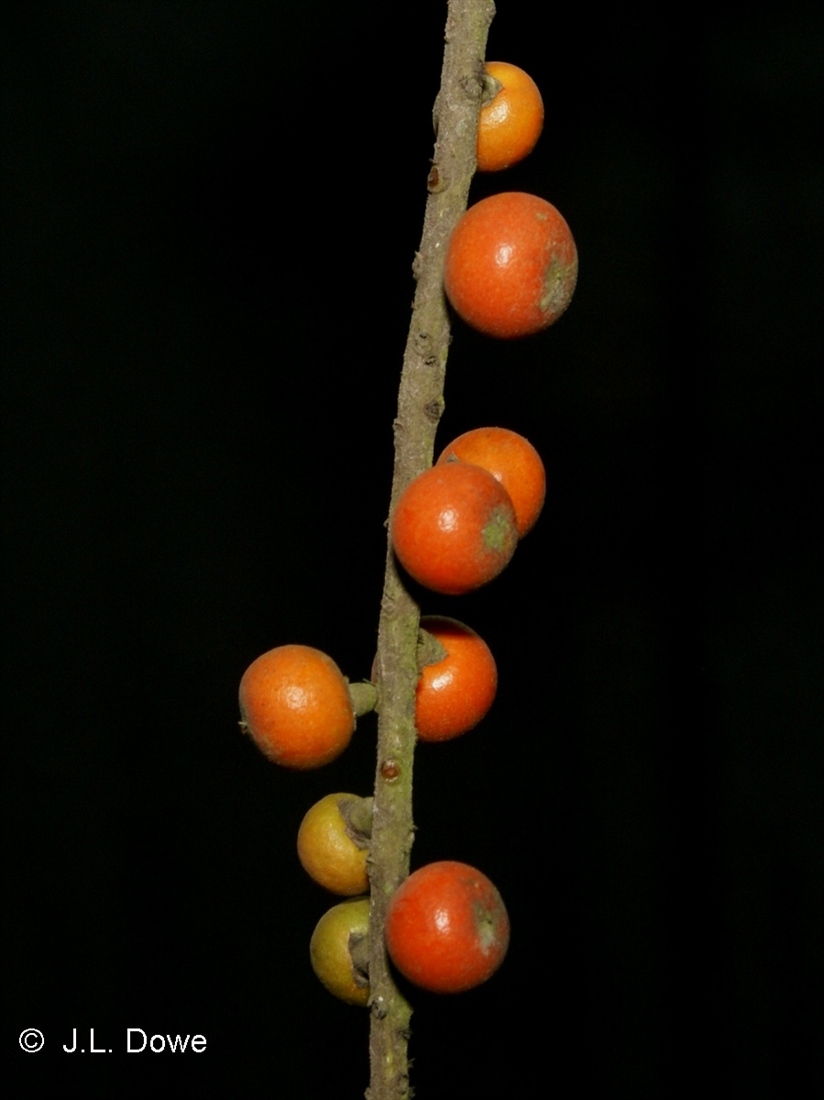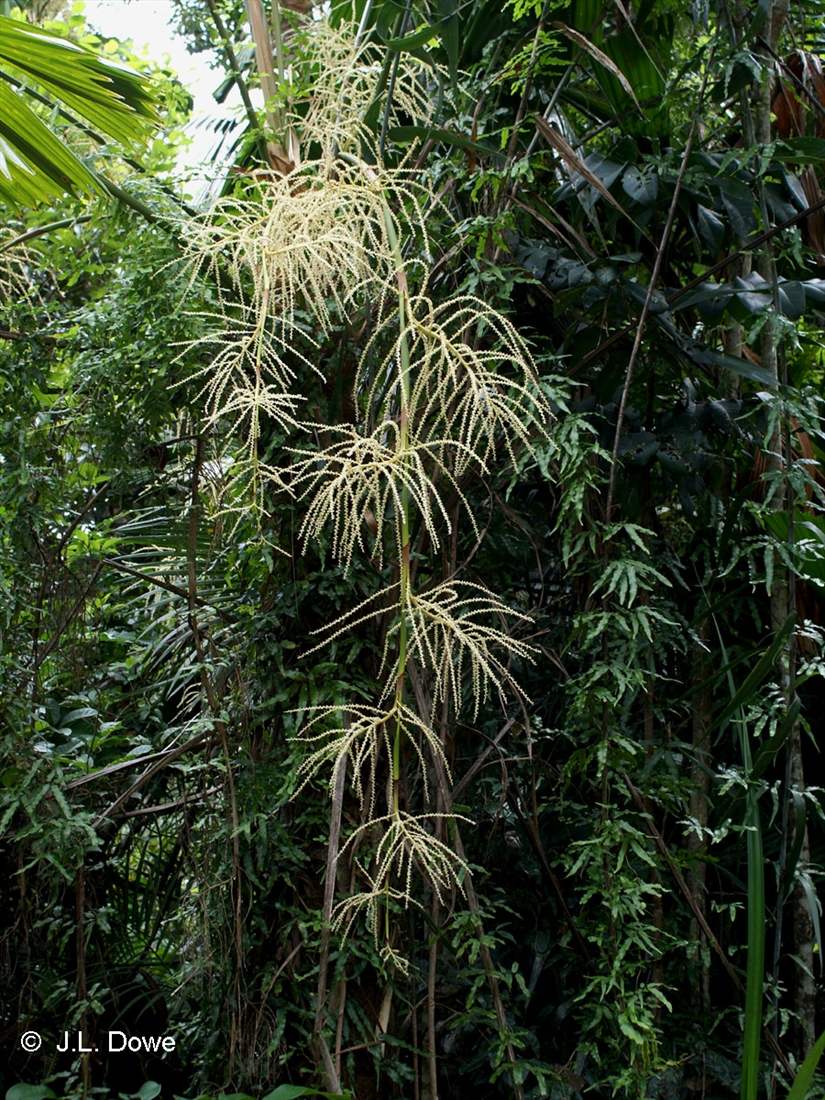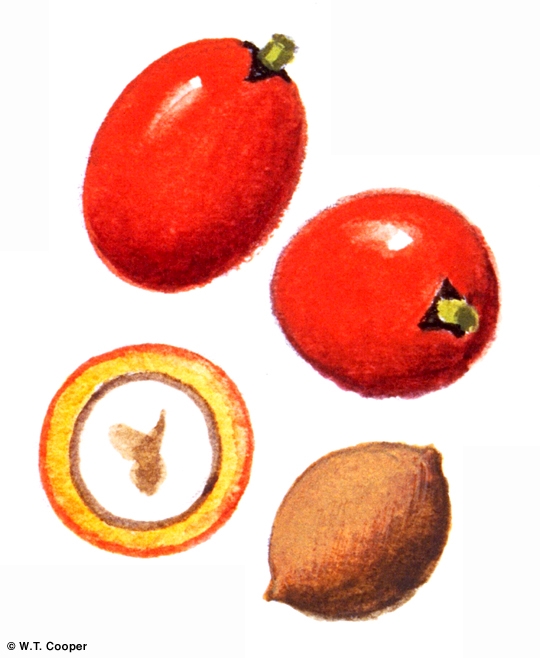Australian Tropical Rainforest Plants - Online edition
Licuala ramsayi (F.Muell.) Domin var. ramsayi






Barfod, A.S. & Dowe, J.L. (2005) Palms 49(1): 20-21.
Fan Palm
Solitary or rarely clustered palm tree. Stem up to 10 m tall and 7-10 cm in DBH.
Crown with 9-12 erect to semi-drooping leaves; leaf sheath up to 100 cm long, and disintegrating into a light to dark brown fibrous mesh that eventually detaches from the leaf. Petiole up to 2 m long, basal part 1.2-1.8 cm in diam., abaxial side from slightly ridged or furrowed basally to flat below the blade, armed with up to 5 mm long, mixed long and short, straight to recurved spines; lamina broadly elliptic to almost circular, glabrous, chartaceous, maximum diam. 1.2-1.8 m in diam., divided into 17-23 segments; the distal 1-3 segments inserted on a rather thick and conspicuous extension of costa, mid segment 7-23 costate, 60-80 cm long, 20-40 cm wide, apex truncate, lateral segments 2-5 costate, 50-75 cm long, 8-18 cm wide, apex truncate, basal segments 2-5 costate, 50-65 cm long, 5-10 cm wide, apex obliquely truncate; indentations mixed long and short, those leading to the adaxial folds 1-5 cm long, those leading to the abaxial folds about 0.5 cm long.
Inflorescences usually several on one palm, 2.0-3.5 m long, arcuate, prophyll 20-30 cm long, green at the base to brown and chartaceous distally, length of peduncle plus first subtending bract 50-70 cm, rachis with 8-10 nodes, subtending bracts tubular, up to 30 cm long, decreasing in size towards the apex, glabrous or with scattered ramenta, first order branches to 25-55 cm long, decreasing in length towards the apex, the proximal ones bearing 15-50, glabrous to sparsely pubescent, 15-30 cm long rachillae. Flowers solitary, in pairs or in groups of 3 or 4, subsessile to shortly pedicellate, subtending bract deltoid to strapshaped, up to 1 mm long, early deciduous; calyx 2.5-3.5 mm long, urn-shaped to cupulate, with three rounded to obtuse lobes, glabrous, cream with brown edges, receptacle and calyx fused for 0.3-0.5 mm; corolla cream colored, 3.3-3.5 mm long, glabrous, turning brown to black after anthesis; stamens 2.0-2.3 mm long, fused to corolla for 1.5-1.7 mm, staminal ring cream-colored at anthesis, truncate, filaments subulate, ca. 0.2 mm long, anthers 0.5-0.6 mm long, rounded to elliptic; ovary ca. 1 mm long, glabrous, turbinate, rounded to truncate apically, style 1.2-1.3 mm long, filiform.
Features not available.
Occurs in NEQ from about Cooktown, south to about Ingham. Altitudinal range from near sea level to 1100 m. Occurs in rainforest, swamp forest, mangroves, littoral forest and in diverse riparian and riverine habitats, on various soil types.
Distinguished by the leaf segments united into irregular multiples; the leaf sheath which disintegrates into a fibrous mesh that eventually detaches from the leaf; the petiole which is conspicuously armed with spines to 5 mm long; and the flowers which are in clusters of 3-4 or solitary.





